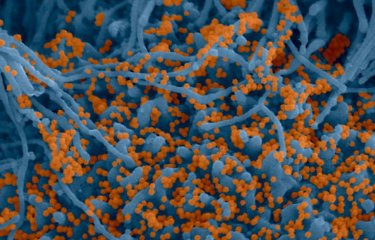-
Article | 2020.06.16
Development of cell lines for research
Aim: to generate a line of specific cells that will serve as a basis to improve characterization of the SARS-CoV-2 coronavirus. The generated cell lines will be useful in facilitating the isolation of clinical samples of coronavirus and in carrying out high-throughput screening
-
Article | 2020.06.16
A technique to identify key cellular factors for SARS-CoV-2 infection
Aim: to carry out CRISPR/Cas9 tests to identify cellular factors involved in infection with SARS-CoV-2 and antiviral proteins that inhibit its replication. These approaches will lead to the identification of key cellular factors that may serve as virulence determinants and therapeutic targets.This research particularly concerns lung cells, the main targets of the virus.
-
Article | 2020.06.16
Building a collection of human biological samples in France
Aim: to detect the presence of specific SARS-CoV-2 antibodies in different populations, either those who traveled to China in the weeks preceding the start of the outbreak, or those with suspected infection with SARS-CoV-2. The aim is to understand:When and how the virus was transmitted from animals to humansWhen the virus began circulating in humans in FranceHow long the infectious period...
-
Article | 2020.06.16
Antibody profiling in recovering patients and development of a serological test for an epidemiological survey in individuals exposed to SARS-CoV-2
Aim: to develop a test that can be used to carry out an initial survey on the prevalence of antibodies in individuals exposed to the SARS-CoV-2 coronavirus. The aim is to obtain a specific serological test that can be used for high-throughput testing for Covid-19 infection.
-
Article | 2020.06.16
SARS-CoV-2 fusion, replication and host responses
Aim: to use cell cultures and mouse models to analyze the role of interferons and IFITMs (interferon-induced transmembrane proteins) in the replication and pathology of the SARS-CoV-2 virus.
-
Article | 2020.06.16
Defective viral genomes (DVGs), potential antiviral inhibitors of SARS-CoV-2
Aim: to use a pipeline to identify the best DVG candidates (molecules known to inhibit viral populations). The pipeline has proven effective in several virus families such as the MERS and murine (MHV) coronaviruses. The scientists propose to use the same method for SARS-CoV-2 and to test the five best DVG candidates on cell cultures. This could lead to DVGs being brought to market as an...
-
Article | 2020.06.16
Profiling SARS-CoV-2 intra-viral and virus-host interactions on the basis of innate immunity signaling
Aim: the coronavirus replication cycle depends on several protein-protein interactions, some between viral proteins to generate functional protein complexes and others with host proteins to inhibit the innate immune response. Identifying these interactions, which are essential for viral infection, can reveal the molecular mechanisms involved in pathogenesis and identify weak points in the...
-
Article | 2020.06.16
Working towards controlled detection of SARS-CoV-2 by the innate immune system
Aim: controlling the SARS-CoV-2 outbreak requires both scientific knowledge and antiviral drugs. RIG-I-like receptors in the cell cytoplasm play a major role in detecting infection with RNA viruses and in initiating and modulating antiviral immunity. The aim of the project is to study the RNA ligands in the SARS-CoV-2 virus that are detected by these receptors. The project will shed light on...
-
Article | 2020.06.16
A SARS-CoV-2 genome sequencing technique to analyze low-quality clinical samples
Aim: viral genomics is a key tool in the response to emerging disease outbreaks like that caused by SARS-CoV-2. But sequencing can be difficult because of poor quality samples or the low ratio of viral to host RNA. This technical project will implement and optimize an approach for processing clinical samples even if they are of poor quality and have a low viral load.This method has worked for...
-
Article | 2020.06.16
Origins, natural reservoirs and interspecies transmission of SARS-CoV-2 and other SARS-like coronaviruses
Aim: to improve understanding of the origins, natural history and dissemination of SARS-CoV-2 and SARS-like coronaviruses in their natural environment. The main focus is to shed light on interspecies transmission (among bats, between bats and other animals, and between bats and humans); this is vital to mitigate the effects of future outbreaks like the devastating pandemic we are currently...


